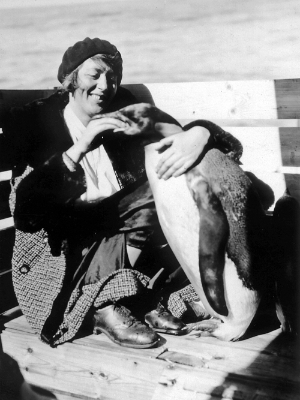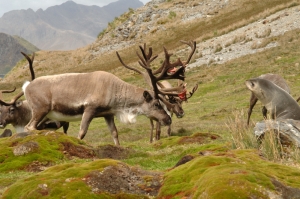Did you know that penguins used to live in Lofoten?
In the 1930s, attempts were made to introduce new animal species to regions where they were not naturally represented. Reindeer were shipped from Norway to South Georgia, and penguins were imported to Norway.
 Mrs. Wegger feeds a king penguin aboard the whale factory ship Thorshavn 1930-31. A few years later the first king penguins were taken to Norway. Photo: Jens Eggvin / Norwegian Polar Institute
Mrs. Wegger feeds a king penguin aboard the whale factory ship Thorshavn 1930-31. A few years later the first king penguins were taken to Norway. Photo: Jens Eggvin / Norwegian Polar Institute
 Reindeer and fur seals on South Georgia. Photo: Kit M. Kovacs and Christian Lydersen / Norwegian Polar Institute
Reindeer and fur seals on South Georgia. Photo: Kit M. Kovacs and Christian Lydersen / Norwegian Polar Institute
In 1936, nine king penguins arrived in Norway with SS Neptune. The birds had been provided by Consul Lars Christensen, who was involved in whaling in Antarctica, and the National Association for Natural Conservation had organised the whole scheme. Two pairs of penguins (male and female) were released at Røst in Lofoten, and two pairs and one juvenile were released at Gjesvær in Finnmark, both release sites in northern Norway. In the ensuing years, other penguin species were released at Røst: macaroni penguins and African penguins. The birds were placed on islands with easy access to the sea and no predators.
Over the years that followed, penguins were sighted in western Finnmark and along the coast of Nordland. This continued until the last observation in 1949. It is not clear whether any of the penguins that had been released managed to reproduce, but some evidence suggests that they did. Not everyone understood what kind of creature these birds were, however. One of the Gjesvær penguins wandered into a farmyard in Gamvik in 1937 and was killed by a matron who claimed it was a freak of nature that had invaded her yard.
Between 1909 and 1925, Norwegian whalers introduced reindeer to the Antarctic island of South Georgia. They did this to ensure that there would be enough food for the people at the whaling stations there. The reindeer adapted well to the new types of forage and the new climate and have reproduced on the island. At present, the population numbers around 3000 individuals, but they pose a threat to the island’s ecosystem through overgrazing and displacement of other species such as seals, penguins and petrels. There are plans to decimate the reindeer population on South Georgia to preserve the species that are endemic on the island.
Today introduction of alien species is considered a threat to the environment. Many countries have legislation that punishes introduction of species with fines or even prison sentences. All scientists who work in Antarctica must wear new clothing and new shoes to prevent unintentional introduction of alien plant seeds. On the cruise ships that ply Antarctic waters, tourists going ashore must take a “footbath” before they leave the mother ship.